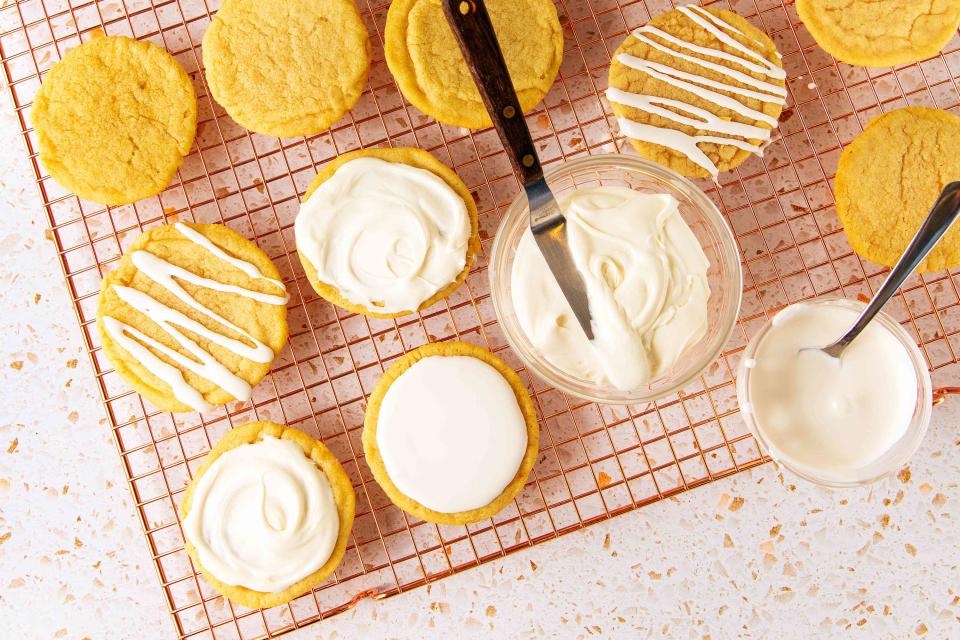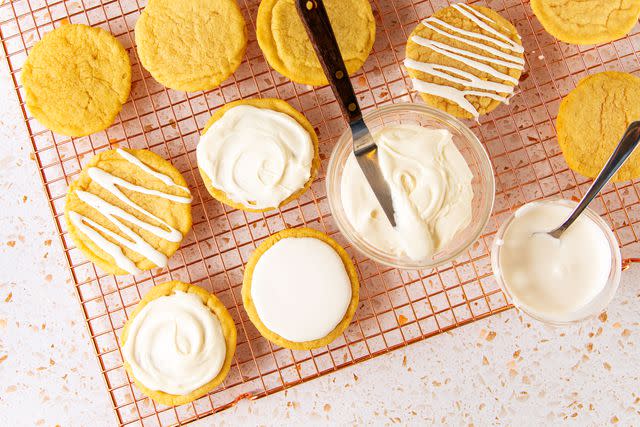What Is the Difference Between Icing and Frosting?
Solve the sweet dilemma of how to top cakes, cookies, doughnuts, and muffins.

Matt Taylor-Gross. / Food Styling by Barrett Washburne
As much as we love cake — and let’s be honest, we really love cake — even the most tender crumbed dessert is fundamentally better when you add frosting or icing. When done well, these additions are essential to the experience of eating cake. They can change the flavor or texture, provide a sticky surface for edible flowers and other garnishes, and in many cases, even help keep the cake from getting stale. Many cake recipes come with specified frostings or icings, which makes things easy, but sometimes you have a basic cake recipe and are left to your own devices on how to finish them. So, what is the difference between frostings and icings, and how do you know what to use when? Here's some advice while you wait for your cake to cool.

Matt Taylor-Gross. / Food Styling by Barrett Washburne
What is frosting?
Frosting is a thick, creamy garnish for cake, that is also used as a filling between layers. It is often used when you want to have a generous, often fluffy coating on the top of things like cupcakes or bars or snacking cakes, or all over the exterior of a layer cake. Frostings include buttercreams, whipped creams, and meringue styles. Some involve cooking of sugar syrups, some incorporate powdered sugar. The simplest style, and the ones most of us learned to make first, are American buttercreams, a fast whipped blend of powdered sugar, softened or melted butter, milk or cream, and flavorings.
What is icing?
Icing is thinner in texture than frostings, and so rather than being spread like frosting, it is often poured or piped over Bundt cakes, pound cakes, eclairs, and some styles of doughnuts. Usually made of powdered sugar and a liquid like orange or lemon juice, milk, cream, or a liqueur, icing provides a nice coating on baked goods. Some icings are thick enough to spread, but they have enough liquidity to then self-smooth, and in some cases, drip generously. The most popular style of icing is Royal Icing, which is made with egg whites, powdered sugar, and water and dries to a hard, shiny gloss. Royal icing is used to decorate sugar cookies, as it can be tinted with food coloring, and the egg whites make it easy to pipe. Much softer are the cream cheese styles of icing, which you might find on top of cinnamon rolls or these Cinnamon Bun Scones.
What are glazes?
Glazes are even thinner than icings, and are designed to be brushed, drizzled or spooned over baked goods like these cinnamon rolls and this lemon pound cake, or to serve as a dip for eclairs and glazed doughnuts. Glazes help to seal moisture in your baked goods by creating a protective layer over them and help those treats stay fresh longer. These are simple to make, mixing powdered sugar blended with enough liquid to make a viscous glaze about the consistency of maple syrup. Glazes are not cooked and are very quick to prepare — a quick and easy way to give baked goods a final flourish.
For more Food & Wine news, make sure to sign up for our newsletter!
Read the original article on Food & Wine.

